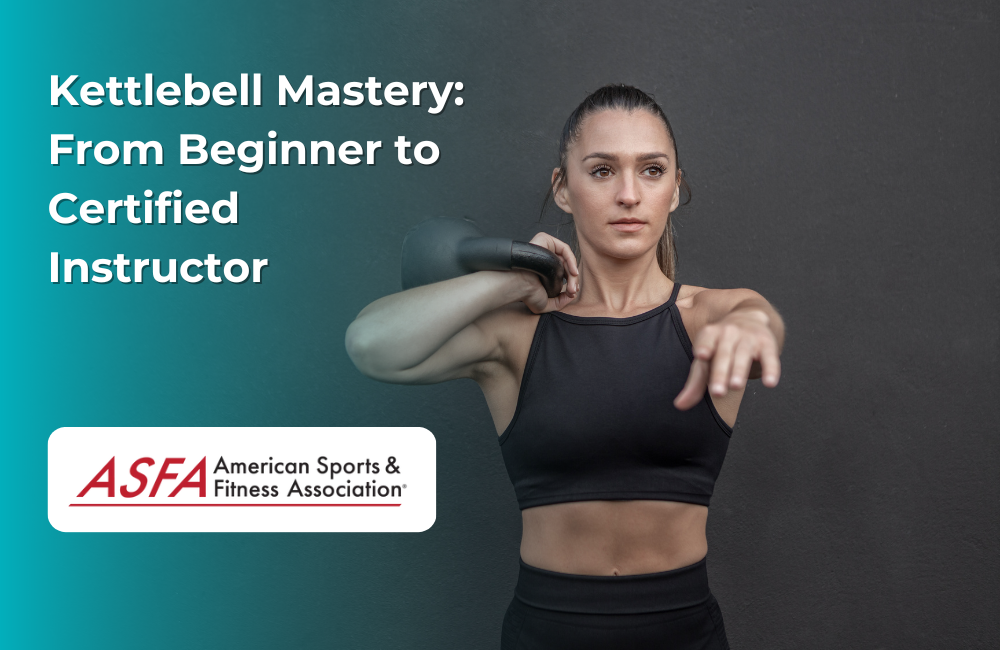Becoming a certified Kettlebell instructor is a transformative journey that allows you to not only master the art of Kettlebell training but also empower others to achieve their fitness goals. This process equips you with the skills, knowledge, and confidence needed to lead safe, effective, and dynamic Kettlebell workouts. For those aspiring to pursue Kettlebell instructor certification, this guide outlines the essential steps and key considerations to ensure you become a skilled and respected fitness professional in this versatile field.
Why Kettlebell Training?
In the ever-evolving world of fitness, kettlebells stand out as one of the most effective and versatile tools for building strength, improving endurance, and enhancing overall functional fitness. Unlike traditional weightlifting, which focuses on isolated muscle groups, kettlebell training involves full-body movements that engage multiple muscle groups at once, thanks to their unique shape that contributes to instability and varied challenges during workouts.
Benefits of Kettlebell Exercises:
-
Full-Body Engagement: Kettlebell movements like swings, cleans, and Turkish get-ups activate several muscle groups simultaneously. A kettlebell exercise such as the swing can enhance strength, stability, and overall fitness by engaging multiple muscle groups and improving cardiovascular health.
-
Functional Strength: These exercises mimic real-life movement patterns, translating into improvements in day-to-day activities and athletic performance.
-
Core Stability and Endurance: Many kettlebell exercises demand balance and core strength, improving posture and reducing the risk of injury.
-
Cardiovascular Benefits: Kettlebell training combines strength with cardiovascular conditioning, making it an excellent option for those seeking to improve both areas in one workout.
Getting Started with Kettlebells
Introduction to Kettlebells and Basic Equipment
Kettlebells are a unique and versatile piece of weight training equipment, characterized by their distinctive shape—a cast iron or cast steel ball with a handle. This design allows for a wide range of dynamic movements, making kettlebells ideal for exercises like swings, presses, and Turkish get-ups. Available in various weights, from a few pounds to over 100 pounds, kettlebells can cater to all fitness levels.
When starting with kettlebells, selecting the right weight is crucial. Beginners should opt for a lighter kettlebell weight to master the basic movements and gradually increase the weight as they build strength and confidence. Investing in a high-quality kettlebell with a comfortable handle and a powder coat finish can enhance grip and durability, ensuring a safer and more effective workout.
Creating a safe training environment is equally important. Ensure you have a clear, non-slip area with enough space to move freely. A mirror can be a valuable tool for checking your form and technique, helping you perform exercises correctly and avoid injury.
Step 1: Choosing the Right Certification Program
The first step on your journey to becoming a certified Kettlebell instructor is to research and choose a reputable certification program. With many options available, it's important to select a program that aligns with your professional goals and values.
Factors to Consider: Kettlebell Weight
-
Industry Recognition: Look for certification programs that are widely recognized and respected within the fitness industry.
-
Comprehensive Curriculum: The program should cover fundamental Kettlebell movements, safety protocols, biomechanics, and exercise programming.
-
Experience: Ensure the certification offers training opportunities and instruction on how to cue and correct form.
-
Accessibility: Consider whether the certification offers online or in-person options depending on your schedule and location.
One reputable organization is the American Sports and Fitness Association® (ASFA®), which provides an accessible and comprehensive Kettlebell certification program designed for fitness professionals at all levels.
Step 2: Studying and Preparing for the Certification Exam
Once you’ve selected your certification program, the next step is to study and prepare for the certification exam. Most certification programs provide study materials that cover a range of topics essential to Kettlebell instruction, including:
-
Kettlebell Fundamentals: Learn how to perform and teach basic exercises such as swings, presses, and cleans.
-
Kettlebell Snatch: Understand the importance of the kettlebell snatch in developing strong glutes and hamstrings. This exercise is a key component in comprehensive kettlebell training programs and is often highlighted in various kettlebell trainings and certifications.
-
-
Proper Form and Technique: Understand the correct body mechanics required to perform movements safely.
-
Exercise Programming: Develop skills in designing progressive and challenging workouts that cater to varying fitness levels.
-
Safety and Injury Prevention: Learn how to avoid common mistakes and ensure clients practice good form to prevent injury.
Take the time to familiarize yourself with these materials and practice the movements until you are confident in your ability to demonstrate and teach them to others.
Step 3: Gaining Experience
Experience is crucial for mastering Kettlebell instruction. Start by practicing Kettlebell exercises on your own, including the high pull to engage your full body core and improve overall physical strength. Pay close attention to the subtleties of each movement, such as how to properly engage your core during swings or maintain balance during Turkish get-ups.
Tips for Mastery:
-
Shadow an Experienced Instructor: If possible, observe certified Kettlebell instructors in action to see how they manage classes, cue movements, and modify exercises for different fitness levels. Notice how kettlebells challenge muscles differently than dumbbells due to their unique shape and unstable nature.
-
Attend Workshops: Participate in Kettlebell workshops or classes to gain a deeper understanding of the different teaching styles and workout structures.
-
Practice Teaching: Once you’re comfortable with your technique, practice teaching friends or colleagues to refine your instructional skills.
This experience will provide the confidence and competence you need to lead your own classes effectively.
Kettlebell Safety and Injury Prevention
Best Practices for Safe Training
Kettlebell training is an excellent way to build strength and improve fitness, but safety should always be a priority. To minimize the risk of injury, follow these best practices for safe kettlebell training.
Start every session with a thorough warm-up, including light cardio and dynamic stretching. This prepares your muscles and joints for the workout ahead, reducing the risk of strains and sprains.
Proper form and technique are paramount in kettlebell exercises. Keep your back straight, engage your core, and use your legs to generate power. Avoid swinging the kettlebell too high or too low, as this can place undue stress on your shoulders and back.
Begin with lighter weights and gradually increase the weight as you become more comfortable with the exercises. This progressive approach helps prevent overexertion and reduces the likelihood of injury.
Listen to your body and take regular breaks to rest and recover. If you experience any pain or discomfort, stop the exercise immediately and consult a medical professional. By following these guidelines, you can enjoy the benefits of kettlebell training while minimizing the risk of injury.
Step 4: Passing the Certification Exam
The final step before becoming certified is to take and pass the Kettlebell instructor certification exam. The exam will typically test your knowledge on:
-
Kettlebell Movements and Techniques: Demonstrate an understanding of proper form and how to teach exercises such as swings, cleans, and presses.
-
Workout Programming: Show that you can design safe, effective, and progressive Kettlebell workouts tailored to various fitness levels.
-
Safety Guidelines: Ensure that you can recognize and prevent common injuries associated with improper technique.
Successfully passing the exam will grant you your certification, officially recognizing you as a qualified Kettlebell instructor.
Step 5: Continuing Education and Specialization
Even after earning your certification, it’s essential to continue learning and developing your skills. The fitness industry is constantly evolving, and keeping up with the latest trends and research in Kettlebell training will enhance your expertise. Advanced kettlebell techniques often involve the use of the bell in various exercises, which can significantly improve cardiovascular health, muscle strength, and overall fitness.
Options for Continuing Education:
-
Advanced Kettlebell Techniques: Explore more complex exercises and variations to keep your workouts fresh and challenging for advanced clients.
-
Special Populations: Learn how to adapt Kettlebell training for specific populations, such as seniors, athletes, or clients with physical limitations.
-
Workshops and Conferences: Attend fitness workshops and conferences to stay updated on new training methods and industry standards.
Many certification programs, including ASFA®, require ongoing education credits to maintain your certification. This not only keeps your skills sharp but also ensures you remain a credible and knowledgeable fitness professional.
Kettlebell Training for Specific Goals
Tailoring Workouts to Individual Needs
Kettlebell training is highly adaptable, allowing you to tailor your workouts to achieve specific fitness goals, whether you’re aiming to build strength, increase endurance, or enhance flexibility.
For strength training, focus on compound exercises that engage multiple muscle groups, such as kettlebell swings, clean and press, and Turkish get-ups. Use heavier weights and emphasize explosive power to maximize muscle growth.
If endurance is your goal, incorporate exercises that challenge your cardiovascular system, like kettlebell swings, high pulls, and snatches. Opt for lighter weights and higher repetitions to build stamina and improve cardiovascular health.
To enhance flexibility, select exercises that target specific muscle groups with controlled, deliberate movements. Kettlebell halos and windmills are excellent choices for improving range of motion and flexibility. Use lighter weights and focus on maintaining proper form throughout each movement.
Consider individual needs and goals when designing a kettlebell workout routine. For example, if you want to improve grip strength, include exercises like kettlebell grips and wrist curls. For core strength, incorporate movements like kettlebell planks and Russian twists.
By customizing your kettlebell workouts to align with your specific fitness objectives, you can achieve more effective results and maintain motivation while reducing the risk of injury and burnout.
Step 6: Launching Your Kettlebell Instructor Career
With your certification in hand, you’re now ready to begin your career as a certified Kettlebell instructor. There are various ways to start teaching Kettlebell classes or incorporating Kettlebell training into your personal training sessions:
-
Teach at Gyms or Studios: Many gyms and fitness studios offer group Kettlebell classes, providing a great platform to share your expertise.
-
Offer Personal Training: Provide one-on-one or small group Kettlebell sessions tailored to individual fitness goals.
-
Host Online Workouts: With the rise of virtual fitness, you can conduct online Kettlebell classes, reaching clients who prefer to train from home.
-
Specialized Workshops: Offer Kettlebell workshops or seminars to attract clients interested in learning this specific training modality.
By offering dynamic, effective, and safe Kettlebell workouts, you’ll attract a broad range of clients looking for full-body, functional fitness training.
Conclusion: Master the Art of Kettlebell Training
Becoming a certified Kettlebell instructor is not just about learning to lift weights—it’s about mastering a comprehensive and dynamic training tool that offers significant benefits to clients of all fitness levels. From functional strength and core stability to cardiovascular endurance, Kettlebell training provides a unique and versatile approach to fitness.
As a certified Kettlebell instructor, you will have the expertise to create challenging yet accessible programs tailored to your clients’ needs, helping them achieve their fitness goals while enhancing your own professional credibility. The journey from beginner to certified instructor is rewarding, offering both personal growth and the opportunity to make a lasting impact on the fitness journeys of others.
Embrace the challenge, and unlock the potential of Kettlebell training—starting with your certification.





